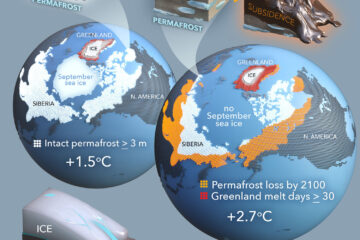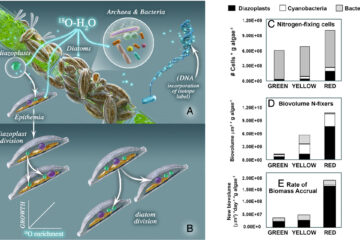Changing land use reduces soil CH4 uptake by altering biomass and activity but not composition of high‐affinity methanotrophs
Forest ecosystems assimilate more CO2 from the atmosphere and store more carbon in woody biomass than most nonforest ecosystems, indicating strong potential for afforestation to serve as a carbon management tool. However, converting grasslands to forests could affect ecosystem–atmosphere exchanges of other greenhouse gases, such as nitrous oxide and methane (CH4), effects that are rarely considered. Here, we show that afforestation on a well-aerated grassland in Siberia reduces soil CH4 uptake by a factor of 3 after 35 years of tree growth. The decline in CH4 oxidation was observed both in the field and in laboratory incubation studies under controlled environmental conditions, suggesting that not only physical but also biological factors are responsible for the observed effect. Using incubation experiments with 13CH4 and tracking 13C incorporation into bacterial phospholipid fatty acid (PLFA), we found that, at low CH4 concentrations, most of the 13C was incorporated into only two PLFAs, 18 : 1ω7 and 16 : 0. High CH4 concentration increased total 13C incorporation and the number of PLFA peaks that became labeled, suggesting that the microbial assemblage oxidizing CH4 shifts with ambient CH4 concentration. Forests and grasslands exhibited similar labeling profiles for the high-affinity methanotrophs, suggesting that largely the same general groups of methanotrophs were active in both ecosystems. Both PLFA concentration and labeling patterns indicate a threefold decline in the biomass of active methanotrophs due to afforestation, but little change in the methanotroph community. Because the grassland consumed CH4 at a rate five times higher than forest soils under laboratory conditions, we concluded that not only biomass but also cell-specific activity was higher in grassland than in afforested plots. While the decline in biomass of active methanotrophs can be explained by site preparation (plowing), inorganic N (especially NH4+) could be responsible for the change in cell-specific activity. Overall, the negative effect of afforestation of upland grassland on soil CH4 uptake can be largely explained by the reduction in biomass and to a lesser extent by reduced cell-specific activity of CH4-oxidizing bacteria.


